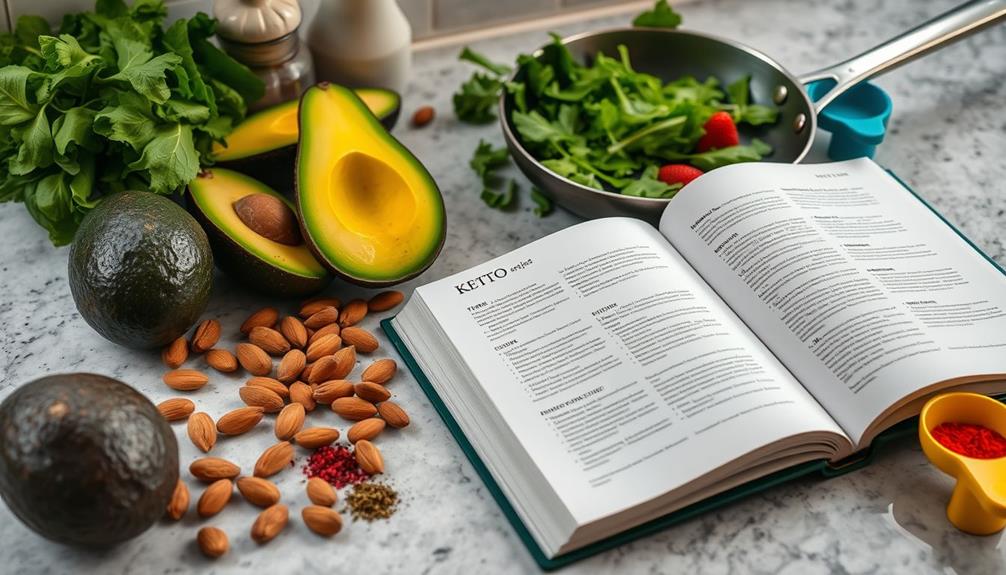Getting into ketosis usually takes a few days to a week, depending on your diet, activity level, and metabolism. You’ll notice your body shifts from carbs to fat burning during this time, often accompanied by symptoms like fatigue or headaches—commonly called keto flu. Staying consistent with low-carb eating, staying hydrated, and maintaining electrolytes can speed up the process. Keep going, and you’ll discover how to optimize your path to ketosis effectively.
Key Takeaways
- Typically, it takes a few days to a week to enter ketosis, depending on individual factors.
- Glycogen depletion and water loss occur early, signaling the body’s shift to fat burning.
- Consistent low-carb intake and high activity levels can accelerate ketosis onset.
- Symptoms like keto flu may appear during transition, indicating metabolic shift.
- Using ketone testing methods can confirm when ketosis has been achieved.

Ever wondered how long it takes to reach ketosis? The answer varies from person to person, but generally, it takes anywhere from a few days to a week. During this passage, you might experience what’s called the keto flu, a set of symptoms like fatigue, headaches, and irritability. This happens because your body is shifting from relying on carbs for fuel to burning fat, a process known as fat adaptation. The keto flu can be discouraging, but it’s usually temporary and a sign that your body is adjusting to its new energy source.
Reaching ketosis takes a few days to a week, with possible keto flu symptoms during the transition.
When you first cut carbs and increase your fat intake, your body begins depleting its glycogen stores. Glycogen, stored in your muscles and liver, holds water, so as it decreases, you might notice weight loss and some initial fatigue. During this period, your body starts producing ketones from fat breakdown, signaling that you’re entering ketosis. It’s important to note that some people experience symptoms of keto flu because their bodies are not yet efficiently using fat for energy, which is part of the fat adaptation process. As your body becomes more efficient at burning fat, these symptoms tend to subside.
The speed at which you reach ketosis depends on several factors: your activity level, how strictly you follow a low-carb diet, your metabolic rate, and your previous diet. If you’re very active and keep your carbohydrate intake below 20-50 grams per day, you might enter ketosis faster. Additionally, staying hydrated and replenishing electrolytes can help minimize keto flu symptoms during this shift. If you’re patient and consistent, your body will adapt and become a fat-burning machine, but rushing this process can prolong discomfort.
It’s also worth mentioning that some people naturally enter ketosis quicker than others due to differences in metabolism or existing body composition. If you’re disciplined with your diet and exercise, you could see signs of ketosis in just a few days, while others might take a week or more. To confirm, many use ketone test strips or blood meters, which provide a clear indication of your ketone levels. Remember, the goal is not just to reach ketosis but to sustain it, which requires ongoing commitment to low-carb, high-fat eating habits. Be patient with your body’s adjustment process, and soon, fat adaptation will take hold, making it easier to maintain ketosis and enjoy the benefits of this metabolic state. Additionally, understanding how metabolic rate affects your ability to reach ketosis can help tailor your approach for more efficient fat burning.
Frequently Asked Questions
Can I Speed up Ketosis With Supplements?
Yes, you can potentially speed up ketosis with supplements, but be cautious about supplement safety. Ketosis supplements, like exogenous ketones, may help raise your ketone levels quickly. However, not all supplements are safe or effective, so research thoroughly and consult with a healthcare professional. Remember, supplements are just an aid; maintaining a low-carb diet and fasting are the most reliable ways to enter ketosis faster.
Does Exercise Affect How Quickly I Enter Ketosis?
Ever wondered if exercise speeds up ketosis? It definitely can, especially when timed right. By increasing your metabolic rate through consistent exercise, you help your body burn through stored carbs faster, pushing you into ketosis sooner. Doing cardio or high-intensity workouts early in your fasting or low-carb phase boosts fat burning. So, yes, exercise timing matters—incorporate it strategically to reach ketosis more quickly and enhance your results.
Are There Signs That Indicate Ketosis Onset?
You’ll notice signs like increased energy, mental clarity, and decreased hunger when ketosis starts. Be aware of ketosis symptoms such as the keto flu, which may cause fatigue, headache, or irritability. These signs typically appear within a few days of starting a low-carb diet. Pay attention to your body’s responses, and remember, experiencing some keto flu symptoms doesn’t mean ketosis isn’t happening—you’re just adjusting to the new metabolic state.
Can Certain Foods Delay Ketosis?
Yes, certain foods can delay ketosis. Consuming keto-friendly snacks high in carbs or not sticking to carbohydrate restrictions slows your progress. Even small amounts of sugar or processed foods can keep your insulin levels elevated, making it harder to enter ketosis. To speed up the process, focus on low-carb, high-fat foods and avoid non-keto-friendly snacks that can hinder your body’s shift into fat-burning mode.
How Does Hydration Impact Ketosis Timing?
Hydration levels and electrolyte balance markedly impact your ketosis timing. When you’re well-hydrated, your body can more efficiently eliminate excess water weight and ketones, helping you reach ketosis faster. Maintaining proper electrolyte balance prevents dehydration and muscle cramps, supporting your metabolic shift. If you’re dehydrated or have imbalanced electrolytes, it may delay ketosis, so drink plenty of water and replenish electrolytes through foods or supplements to optimize your progression.
Conclusion
Getting into ketosis is like planting a seed—you’ll see sprouts in about 2 to 4 days if you stick to low-carb, high-fat eating. Remember, everyone’s body is different, so it might take a little longer or shorter. Stay patient and consistent, and you’ll soon be sailing smoothly in keto waters. With dedication, you’ll open the door to fat-burning bliss—just keep moving forward, and you’ll get there faster than you think.









